Take the Crown: Basquiat Painting Investments for Your Collection
No artist shook up the NYC art scene with the boldness and originality of Basquiat. Here’s why his art still attracts collectors like Jay Z and Leonardo DiCaprio.
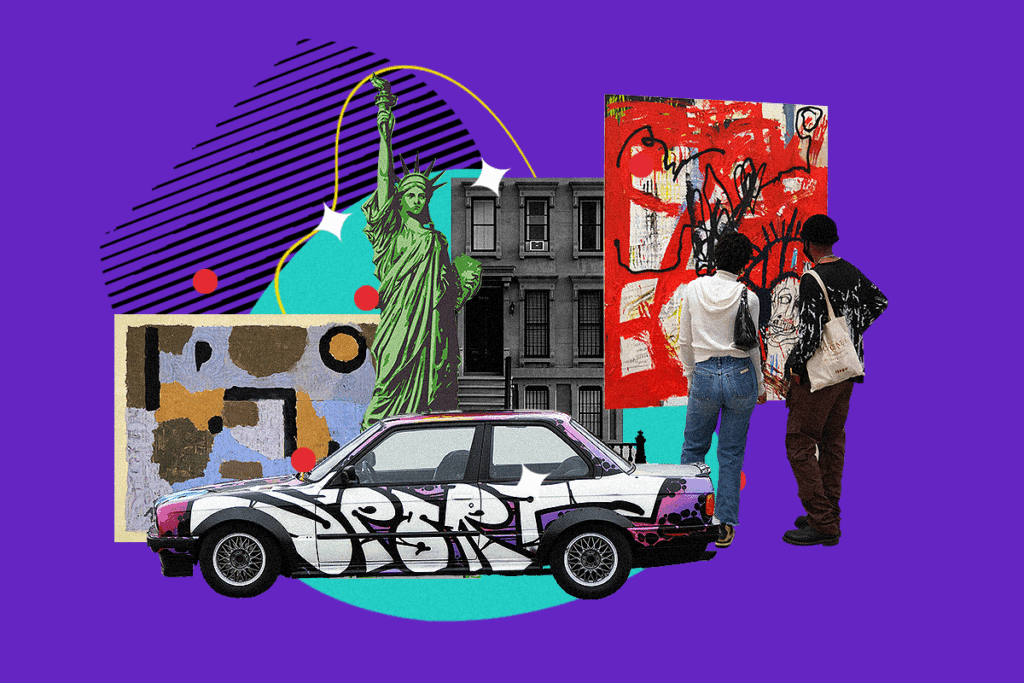
- Jean-Michel Basquiat’s 1982 Untitled painting is the second most expensive artwork by an American artist
- Basquiat has attracted the attention of art collectors, artists, and celebrity creators for 40 years.
- Masterworks’ offerings to invest in Basquiat paintings have a net average return of 29%
Blue-chip art has long been an asset class for the ultra-wealthy, and more investors are able to take advantage of its perks. Fine art has an inverse correlation to the stock market, and it consistently outperforms the S&P 500, making it an ideal alternative investment.
Not only are the investors and their methods changing, but also what qualifies as fine art. The position Jean-Michel Basquiat occupied in the art world was debated throughout his short life. But that hasn’t kept his work from becoming coveted assets.
Basquiat’s work has increased in value over the past three decades, with prices for his paintings climbing from $2,500 in 1986 to over $10 million in 2021.
The attention of celebrity collectors increased the visibility and value of his work, with famous figures like Leonardo Dicaprio and Jay Z hunting down the neo-expressionist’s paintings (Madonna, unfortunately, returned hers after breaking up with the artist).
They don’t just sound and look good, though—Basquiat’s work historically appreciated 22% annualized between 1986 and 2018, and the average price of his artwork has been close to or over $3 million since 2016. In 2021, it jumped to nearly $12 million.
We’ve got everything you need to know about Basquiat, his work, and how you can invest in his continued ascent.
Who was Jean-Michel Basquiat?
Basquiat was hard to define as an artist. He did graffiti and passionately studied art history and anatomy. He both courted and mocked fame, alternating between walking the runway in high fashion shows and attending events in paint-splattered Armani suits. The collage style of his paintings reflected his own layers, and that complexity garners the appeal of collectors and artists to this day.
Jean-Michel Basquiat
- Born: 1960
- Years active: 1978–1988
- Nationality: American
- Died: 1988
- Style and medium: Neo-expressionist collage paintings and drawings
- Well-known works: Defacement: The Death of Michael Stewart (1983), King Alphonso (1983), The Irony of a Negro Policeman (1981)
- Highest sale: Untitled (1982) for $110.5 million in 2017
Radiant child
Born to Haitian and Puerto Rican parents in 1960, Jean-Michel Basquiat was a creative and precocious child. He was an avid reader and writer by age four—in three languages by age eleven. He showed an early interest in art and writing, and his mother encouraged his artistic talent. Some of the imagery in the artwork of his youth became motifs in his later paintings.
Like many creatives, Basquiat struggled in school. But several teachers of his encouraged his artistic interests. He wrote a children’s book with a classmate at seven years old and contributed his writings and drawings to the school newspaper as a teenager.
Teachers could deal with Basquiat cutting classes with his friends, but they couldn’t protect him from expulsion when he smashed a pie in the principal’s face. Basquiat’s father kicked the 17-year-old out of his home, thus launching the young artist into the cultural hotbed of the Lower Manhattan art scene.
SAMO on the streets
While still in high school, Basquiat and his friend Al Diaz began tagging graffiti messages signed SAMO©. The signature was an inside joke, shorthand for the “same old shit” they saw in popular culture and the New York City art industry. SAMO began as a fictional religion that Basquiat and Diaz wrote stories about, and they extended these tales off the page and onto buildings in Lower Manhattan.

Source: dazeddigital.com
The popularity of graffiti in the 1970s meant SAMO© had to share space with dozens of other tags, but the duo’s cultural commentary piqued the interest of the street art world.
From the street to the studio
Soon, Basquiat’s work caught the attention of art collectors in New York and around the world. He painted on random objects recovered from the trash and curbsides, using broken doors and scraps of fabric as canvases. But that didn’t deter the art world—just two years after his first showing at the indie Times Square Show, Basquiat was one of the youngest artists to participate in the prestigious Whitney Biennial. His work drew the attention of artists and art collectors worldwide.
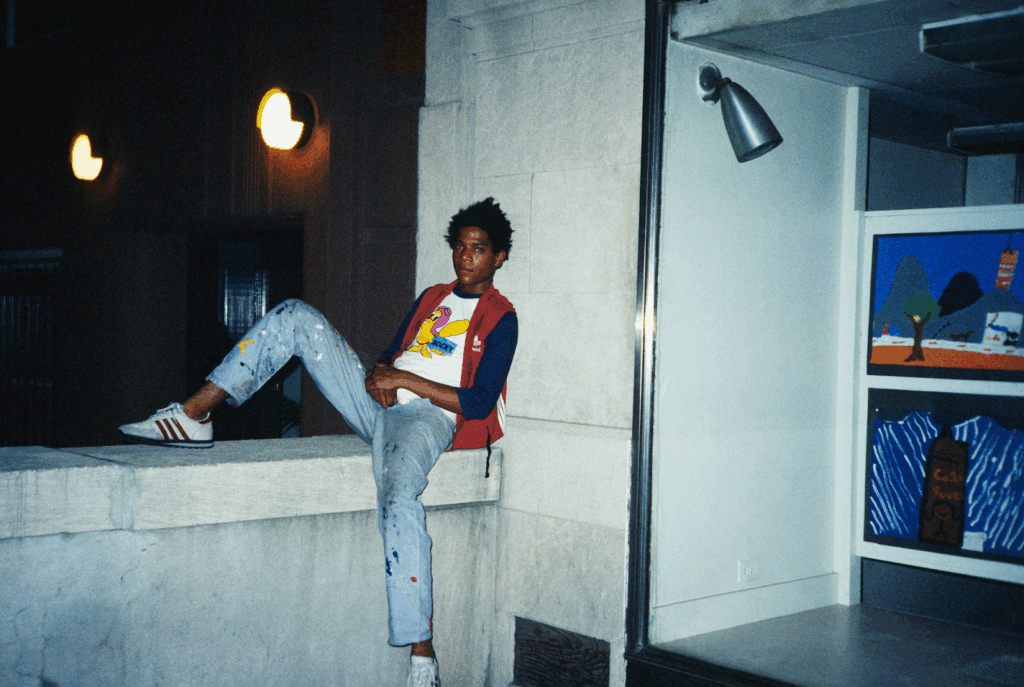
Source: paigepowellphotography.com
A brief, bright flame
Basquiat’s rise to fame was swift, and many were drawn by his light and promise. While there were plenty of haters dismissing Basquiat’s work, he had many fans and supporters. In addition to famous musicians like David Bowie, Debbie Harry, and Grace Jones—and his 1983 relationship with a then-unknown Madonna—Basquiat developed a close relationship with his friend Andy Warhol.
Warhol and Basquiat’s friendship resulted in several collaborative paintings. While the critical reception of their co-creations was poor, the friendship was intimate and nurturing. Basquiat struggled with addictions to cocaine and heroin throughout his 20s, and Warhol was said to have positively influenced him to reduce his drug use.

Source: warhol.org
When Warhol died in 1987, the entire art scene mourned, but no one more deeply than Basquiat. Just 18 months later, the young artist suffered a heroin overdose and died at 27 years old.
What did Basquiat paint?
Basquiat’s work is best known for his layered collage paintings with suggestive dichotomies of wealth versus poverty and the inner self versus outer experience. His iconic style continues to inspire contemporary street art, hip-hop music, and even collections with high-end brands like Coach and Supreme.

Source: StockX
Across the drawings, paintings, and sculptures Basquiat produced in his short career, many symbols and motifs repeat in different settings. Let’s take a look at some familiar Basquiat themes and imagery.
Crowning glory
The signature Jean-Michel Basquiat crown is one of the most recognizable motifs of the artist’s work. There are many theories about the crown’s symbolism: Basquiat’s desire for fame and recognition, a commentary on wealth and class, or an indicator of his talent and significance.

Source: jeanmichelbasquiat.org
Some critics see the crown as a marketing tool, pointing out the shift from four- and five-pronged crowns to the iconic three-pointed version. Basquiat displayed a talent for marketing in his graffiti days when he made his and Al Diaz’s SAMO tags stand out in the crowded galleries on the New York City streets.
An anatomical eye
Basquiat paintings have a distinctive, cartoonish style, but they’re also influenced by precise, detailed medical diagrams. When Basquiat was a child, his mother brought him a copy of Gray’s Anatomy and the young artist fell in love with diagrams of human body parts.
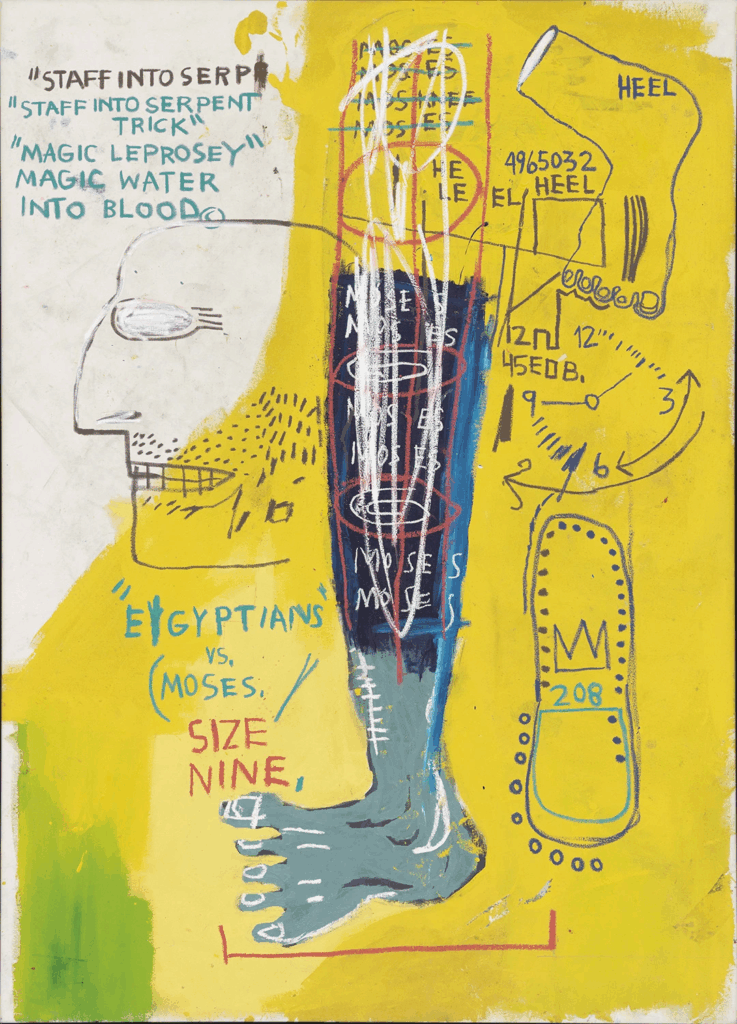
Source: Masterworks.com
The influence of these diagrams is clear in many of Basquiat’s paintings and drawings. Much of his artwork blends techniques and motifs that combine elements of African art with New York graffiti, hip-hop iconography, original poetry, and anatomical drawings. The features of medical diagrams give Basquiat’s work complicated layers and create a contrast between the abstract and realistic.
Race, power, and money
In the 1980s, Basquiat was one of few Black artists in his scene, but he didn’t shy away from portraying the Black experience. He often drew Black historical figures in his work, usually placing his signature crown over their heads. Basquiat said that he rarely saw art that featured Black people, and never depicted as protagonists, so that’s what he wanted to create.
He also illustrated the injustices Black Americans have faced to date. One of his most recognized works about race and power was Irony of a Negro Policeman (1981). The painting features Basquiat’s signature collage style and elements that recur in his other work, like skulls and handwritten text.
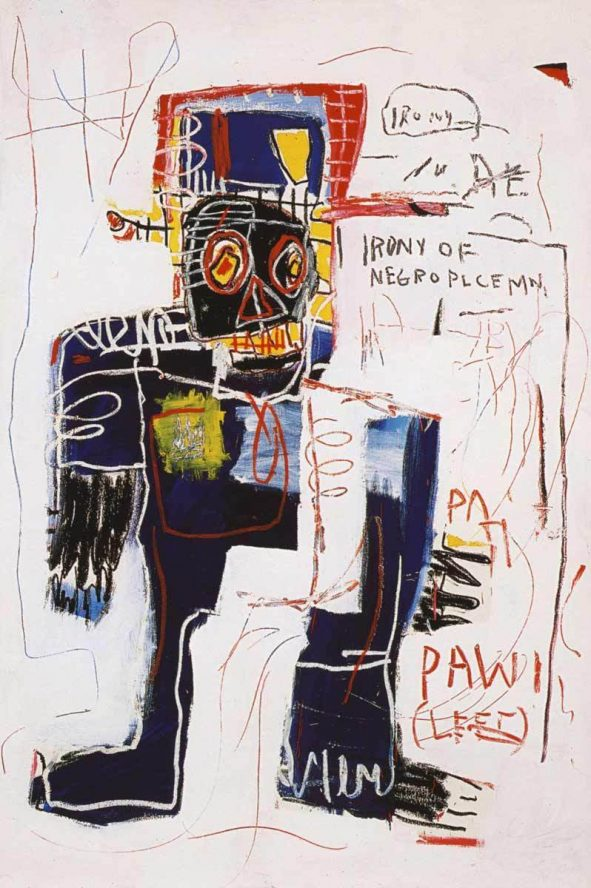
Source: sketchline.com
The painting highlights the tension of living in a culture that both punishes and tokenizes Black Americans. Words like “irony” and “pawn” are scrawled as Basquiat’s critique of playing by the rules of the oppressor. He also uses Haitian Vodou imagery—the black and white figure with its skull-like face is similar to depictions of the Vodou underworld spirit of Baron Samedi. The painting can be interpreted as a statement on the deaths caused by police brutality or the discord of Black police officers.
The painting was exhibited at the Whitney Museum, the Brooklyn Museum, and the Musée d’Art Moderne in Paris. It sold for $12.65 million in 2012, the same night that Olympics (1984), a piece Basquiat created with Warhol, sold for over $10 million.
Are Basquiat paintings a good investment?
Fine art investments have delivered promising returns over the past decade. The value of contemporary blue-chip art has increased 132% over the past 10 years, and the asset class tends to move opposite the stock market. That means your fine art investments are safe from market crashes and dips.
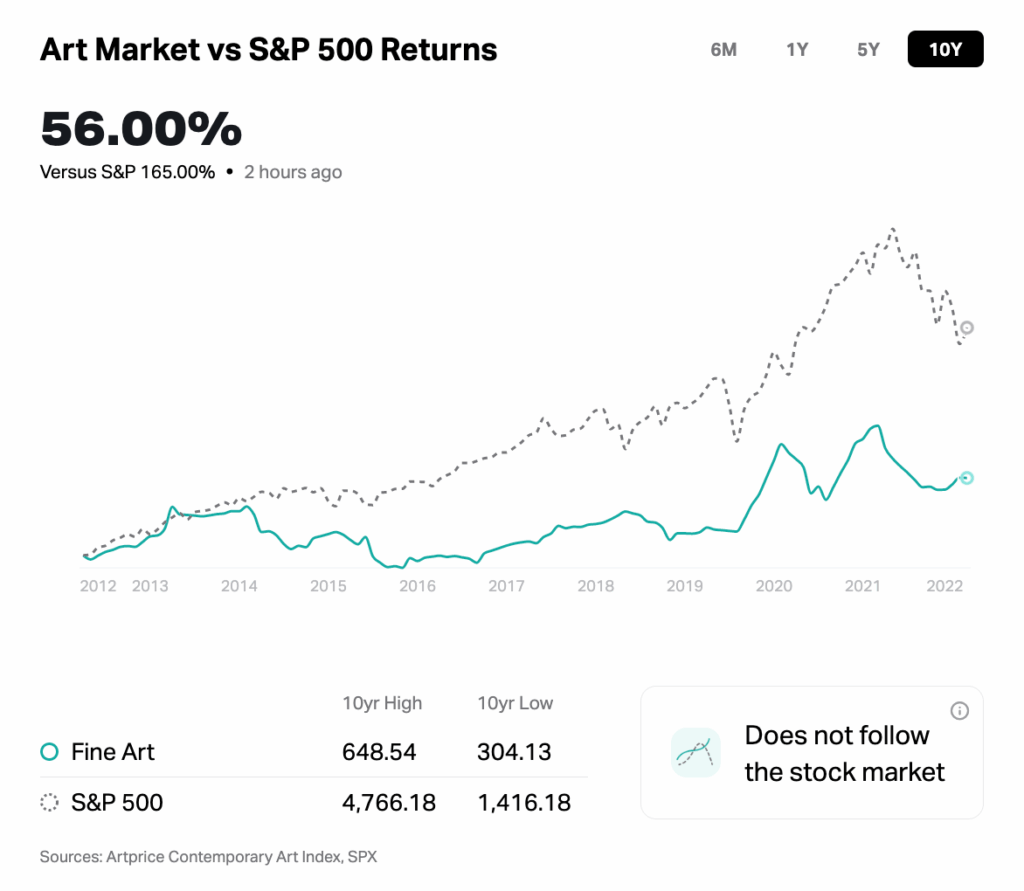
Basquiat’s work has increased in value over the past three decades. The prices of his paintings climbed from $2,500 in 1986 to over $10 million in 2021. And the total turnover for his work reached an all-time high of $439,339,428 in 2021, second only to Pablo Picasso.
Record-smashing returns
While it’s no surprise that Basquiat’s unique paintings have grown in popularity and value since his tragic death, one 2017 sale stunned the art industry. The auction of Basquiat’s Untitled (1982) at Sotheby’s brought in over $50 million more than its estimated sale price. The sale set records for most expensive work by an American artist (though beaten by an Andy Warhol print in 2022) and for most expensive work by a Black artist.
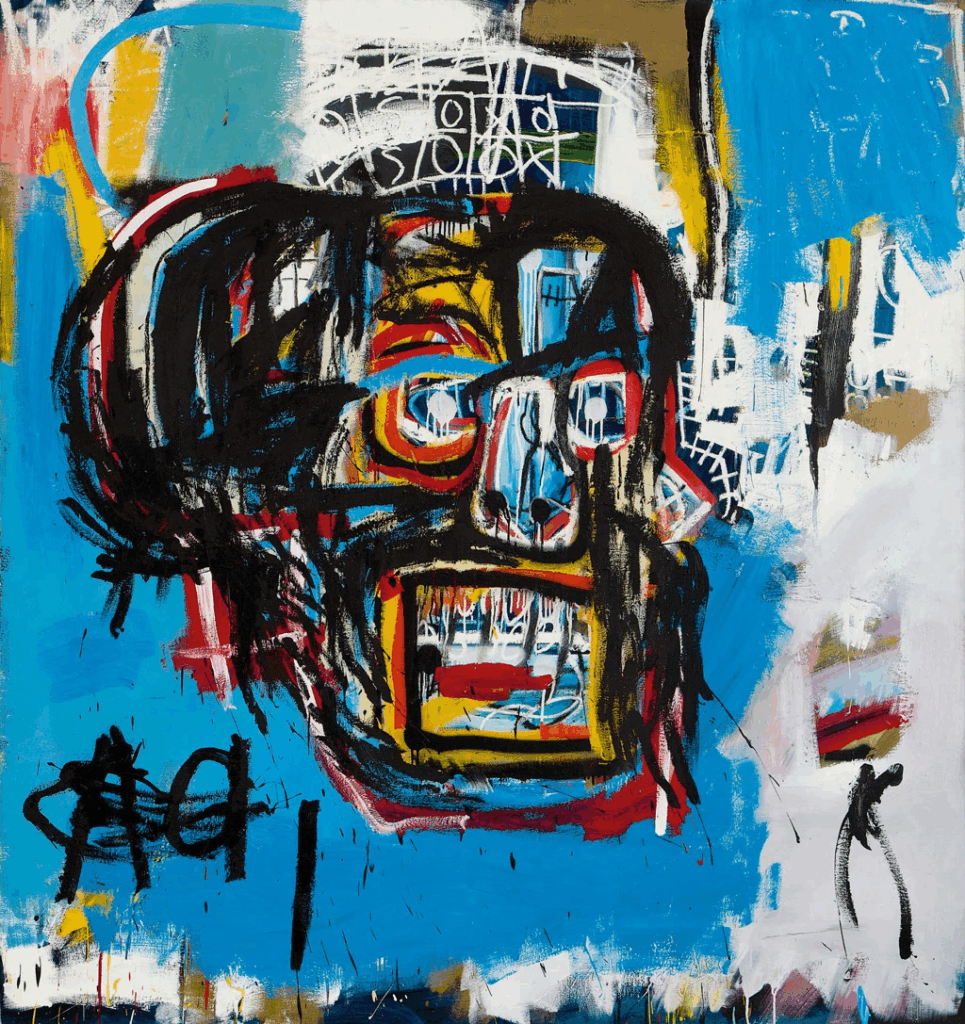
Source: artnews.com
The Untitled Basquiat painting had last sold for $19,000 in 1984. When it came back to auction in 2017, a heated bidding war drove the price up to $110.5 million. That value increase over 33 years gives the painting an annualized growth rate (IRR) of nearly 27%. Compared to the 10.1% return the Nasdaq composite delivered during the same timeframe, Basquiat’s work seems like a promising investment.
Long-term rewards
While the nine-figure sale of Untitled (1982) is astonishing, Basquiat’s work seems to bear impressive value appreciation over time. The price database at Masterworks shows that holding these paintings for 20 years or more returns at least 5x and up to 720x the initial purchase price.
Consistently climbing
Since the 2017 sale, prices for Basquiat’s work have continued to rise to staggering levels. One of his largest paintings, Untitled (Devil) from 1982, sold for $4.5 million in 2004. When it returned to auction in 2016, it sold for $57.3 million, but it soon outdid itself again with an $85 million sale in 2022.

Source: christies.com
And in 2021, one of Basquiat’s 1982 paintings from his time in Italy sold for $50.8 million. Versus Medici was purchased for an undisclosed price in 1990 and held in a private collection for 31 years.
How can you invest in a Basquiat painting?
Whether you have the perfect spot to hang a Basquiat original or want to swipe through his work on your phone, there are various ways you can invest in this iconic artist.
Bid-by-bid
Highbrow auction houses like Sotheby’s and Christie’s are where you’re most likely to find lots featuring rare and exciting artwork by Basquiat and Warhol. If you want to own a valuable piece of art history, be prepared to spend big and spar with competitive bidders.
Many art collectors who are interested in Basquiat’s work are also billionaires with plenty of room in their private galleries for another alternative asset. But even if you’re not Yusaka Maezawa or Jay Z, Basquiat can still be a part of your collection.
Enjoy the fund
Yieldstreet has launched several art investment funds with the mission of making the fine art asset class more accessible. They let you invest in works by contemporary artists like Banksy and Yayoi Kusama, as well as pop artists like George Condo and Keith Haring. They also created an Artists of Harlem fund that featured the work of Harlem Renaissance artists, such as Faith Ringgold and Alice Neel.
The company seems to be betting on Basquiat—his work is featured in their Art Equity Fund IV, and they sponsored the 2022 King Pleasure Basquiat exhibit at the Brooklyn Museum.
Yieldstreet reports that their art investments have brought in a net annualized return of 12.2%, which falls slightly below their target return of 15 to 20%, but outperforms the S&P 500’s return of up to 10% over the past 25 years.
Share the wealth
Fractional investment platforms offer a new way to invest in fine art. They enable investors to buy shares in valuable artworks to make investing in them easier and more accessible. Your shares are similar to a company’s stock—their value will increase or decrease along with the value of the artwork—and you can often sell them through secondary marketplaces, similar to stock trading.
Masterworks has offered investments in ten Basquiat paintings so far, including his 1982 All Colored Cast (Part II) in 2021 and 1983’s Early Moses. For a minimum investment of $10,000, investors of all levels can buy shares in a Basquiat and make a profit when it’s sold. Masterworks offerings have had a net average return of 29% on exits, and their portfolio of offerings has had an annualized appreciation of 15% since 2019.
With Basquiat’s star continuing to rise, investing in his artwork could be a stroke of brilliance.
